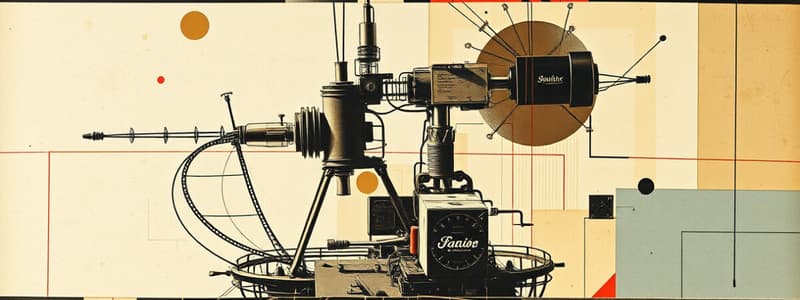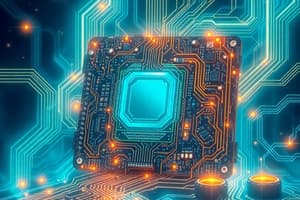Podcast
Questions and Answers
What is the primary function of RAM in a computer system?
What is the primary function of RAM in a computer system?
- Long-term data storage
- Booting the operating system
- Processing binary data
- Temporary storage of frequently used instructions (correct)
Which of the following statements about cache memory is true?
Which of the following statements about cache memory is true?
- Cache memory has the same size as CPU registers.
- Cache memory is located on the hard drive.
- Cache memory is permanently written onto the hard drive.
- Cache memory is faster than RAM but slower than CPU. (correct)
Which of the following correctly describes a bit?
Which of the following correctly describes a bit?
- A unit representing 4 volts in binary data.
- The basic unit of digital information, representing 0 or 1. (correct)
- A fixed storage space in RAM for data manipulation.
- The smallest storage unit composed of 2 bytes.
What role does ROM play in a computer system?
What role does ROM play in a computer system?
What does the DATA BUS do in a computer system?
What does the DATA BUS do in a computer system?
What is the main purpose of an Information System (IS)?
What is the main purpose of an Information System (IS)?
Which of the following devices is classified as a portable computer?
Which of the following devices is classified as a portable computer?
What device is described as never including a keyboard?
What device is described as never including a keyboard?
Which of the following best defines a Database (DB)?
Which of the following best defines a Database (DB)?
What type of memories are classified as permanent?
What type of memories are classified as permanent?
How is memory capacity typically measured?
How is memory capacity typically measured?
Which of the following devices always includes a GSM card?
Which of the following devices always includes a GSM card?
What characterizes an E-Reader?
What characterizes an E-Reader?
Flashcards are hidden until you start studying
Study Notes
Information Systems
- Information System (IS) organizes the collection, organization, storage, and communication of data.
- Database (DB) refers to a large amount of related data adhering to specific static or dynamic restrictions.
System Units
- Mainframe computers serve large organizations for task-critical applications, enterprise resource planning, and transaction processing.
- Microcomputers (desktops) are small computers that use a microprocessor as the CPU, integrating memory and I/O on a single motherboard.
Types of Computers
- Laptops are portable computers designed for mobile use.
- Notebooks are smaller and lighter than laptops.
- Tablets and iPads are even smaller than notebooks and typically do not include a keyboard.
- iPods are compact devices without GSM capabilities.
- iPhones and mobile phones include a GSM card and provide communication functions.
- Devices like iPhones, iPads, and iPods run on Apple's iOS operating system.
- E-Readers allow users to read digital content such as eBooks and newspapers.
Memory Types
- Memory capacity is measured in Bytes and is categorized into permanent and non-permanent types.
- Permanent memories include ROM and storage devices (USB Flash, Hard Disk, CD-ROM, Floppy disk).
- Non-permanent memories consist of CPU registers, RAM, and Cache Memory.
RAM and Storage
- Random Access Memory (RAM) stores frequently used program instructions and enhances system performance.
- Modern RAM typically has a capacity of around 4 GB, with memory arranged in Bytes, each with an address system.
- A Byte consists of 8 bits, where each bit represents a binary value (0 or 1).
ROM and Cache Memory
- Read Only Memory (ROM) is essential for booting the computer and contains vital system operation instructions.
- Cache Memory serves as a faster intermediary storage between the CPU and RAM, typically around 256 KBytes in size, optimizing data retrieval speed.
Data Communication Components
- Data Bus (BUS), made of copper lines on the motherboard, connects the CPU to Cache, RAM, and other ports, facilitating data transfer among components.
Studying That Suits You
Use AI to generate personalized quizzes and flashcards to suit your learning preferences.




